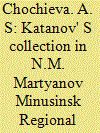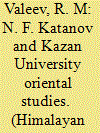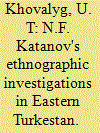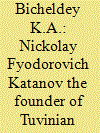|
|
|
Sort Order |
|
|
|
Items / Page
|
|
|
|
|
|
|
| Srl | Item |
| 1 |
ID:
128495


|
|
|
|
|
| Publication |
2013.
|
| Summary/Abstract |
Twelve files, which include the correspondence between N. F. Katanov and N. M. Martyanov, are kept in the archive of Minusinsk Regional museum of local lore'. They give an opportunity to evaluate the contribution of N. F. Katanov to the development of the museum and his interest in his homeland. N. F. KatanOv's letter of 24 January 1894 from Saint Petersburg concerning decoding of Orhon and Yenisei Old Turkic inscriptions is highly characteristic: "Herewith I send my book of script for the museum. Be glad and let all Siberia be glad! In December 1893 Danish researcher W. Thomson and our researcher V. V. Radloff found the most correct key for reading Runic inscriptions. Radloff grew young for 30 years. The script is original, phonetic. About six months ago, Radloff had only guessed and now at the direction of Thomson (with whom he corresponded) and underhis new considerations he learnt to read absolutely fluently. One inscription dates from 738 AD and testifies about Chinese trade with the Arabs and Siberia. . .''.Z
|
|
|
|
|
|
|
|
|
|
|
|
|
|
|
|
| 2 |
ID:
128492


|
|
|
|
|
| Publication |
2013.
|
| Summary/Abstract |
This paper gives an appraisal of Katanov, one of the outstanding founders of Kazan University School of orientalism in the second half of nineteenth and early twentieth centuries. Professor N. F. Katanov is one of the bright and ?amboyant national scholar-thinkers, outstanding representatives of Russian science, education and culture. His life journey and activity reflected important events and tendencies of indigenous and oriental studies. N. F. Katanov's multifarious scientific and pedagogic activity is an unquestionable evidence of great achievements of indigenous orientalism at the turn of nineteenth-twentieth centuries. And his contribution to the development of Kazan oriental studies in this period is indeed invaluable. Since his studentship in Petersburg (1884-1888), his expedition to Southern Siberia and Eastern Turkestan (1889-1892) and tutorage in Kazan (1894-1922), N. F. Katanov's orientalistic activity is connected with complex research of languages, ethnography, folklore and generally spiritual life of the Turkic peoples in Sayan-Altai, Xinjiang, Volga region and Transurals. He had great in?uence on the development of indigenous Turcology in this period.
|
|
|
|
|
|
|
|
|
|
|
|
|
|
|
|
| 3 |
ID:
128489


|
|
|
|
|
| Publication |
2013.
|
| Summary/Abstract |
By order of Russian Geographic Society and Russian Academy of Science, 'N. F. Katanov was preparing for the ethnographic and linguistic investigations in South Siberia, Kazakhstan and Eastern Turkestan. In December 1888 he visited a key region of the Yenisei, Uryankhai region for his research of the Tuvinians' (the Uryankhais and Soyons') language and culture, where he stayed till autumn of 1889. From there he went to the regions of rivers Agul, Biryusa and Uda to the Karagas people. There he had been working till April 1890. Later, the texts collected there were publishedl. From the Karagas people N. F. Katanov continued his travel to Semirechye, then in summer 1890 through Chuguchak to Urumchi, to the residency of a governor of Eastern Turkestan. He spent his winter and the beginning of 1891 in Tarbagatai, where having received emperor's letter from Beijing he started to travel around Gansu-Xinjiang again and got to Myao-orl-du (High monastery) which was situated a little bit more eastern from Komul. In March 1892 he hit the road from Komul to Turfan, from where he went through Urumchi, Gulja and through Semirechye again to Minusinsk from where he returned to Saint~Petersburg in December 1892. In Semirechye and Tarbagatai, Katanov researched the language and customs of the Kazakhs from kins kerei, argyn, naiman and Sarat citizens and in Chinese Turkestan he studied the language and traditions of the local Uygursz. In Germany there is some part of ethnographic and linguistic material which was collected by professor N. F. Katanov from the population of north-eastern part of Eastern Turkestan, whidi was famous in the written sources before as Uiguristan (country of the Uygurs).
|
|
|
|
|
|
|
|
|
|
|
|
|
|
|
|
| 4 |
ID:
128490


|
|
|
|
|
| Publication |
2013.
|
| Summary/Abstract |
Tuvinian studies is a comparatively new branch in Russian science and represents a set of scientific actions of collective and individual character. In a broader meaning it is a knowledge system about Tuva and the
Tuvinians. Its formation, further development and expansion are connected with the activity of Imperial Russian Geographic Society (IRGS) in the investigation and study of Central Asia in the second half of nineteenth and early twentieth century. The period from 1842 till 1945 can be conditionally called as "the
golden age" of Tuvinian studies. Undoubtedly it was preceded by a range of Tuvinian studies / researches in sixteenth to nineteenth centuries. In this period of history Russian empire strengthened the spread of its
geopolitical interests in Central Asia. Independent explorers and entire expeditions from Russia went to Mongolia, China and Tibet for different purposes including scientific ones. Frequently their pathway ran through the Uryankhai region (one of the former names of Tuva at that time), so explorers and researchers included Uryankhai (Tuva) in the plans of their investigations. Eventually general interest of the Russian empire and its scientific society in Central Asia led to the execution also of special investigations about Tuva.
|
|
|
|
|
|
|
|
|
|
|
|
|
|
|
|
| 5 |
ID:
128472


|
|
|
|
|
| Publication |
2013.
|
| Summary/Abstract |
One of the most unexplored aspects of N. F. Katanov's life is his social activity. Researchers distinguish several directions of N. F. Katanov's social activity: activity in scienti?c societies, museum and literature work, lectures, translation, editing and publishing activity. A researcher of the Tatarstan Republic National archives G. A. Dvoenosova, having conducted a study on Kazan ecclesiastical academy fund, where N. F. Katanov worked from 1911, notes that he was a member of 9 scientific societies: Imperial Russian archaeological society (since 30 March 1884 - a member-officer, since 10 March 1898 - an actual member), . .iperia1 Russian geographical society (since 17 December 1894 - an actual member), Imperial Society of natural science, anthropology and ethnography (since 22 November 1897 - an actual member), Society of archaeology, history and ethnography attached to Kazan University (since 18 March 1898 - chairman, since 22 February 1909 - an honorary member), International society of sciences and literatures in Leuven (Belgium) (since 14 February 1898 - an ordinary member); Hungarian ethnographical Society in Budapest (since 17 March 1899 - a foreign member), Helsingfors Finno-Ugric (since 20 November 1900 - an actual member)'
|
|
|
|
|
|
|
|
|
|
|
|
|
|
|
|
| 6 |
ID:
128499


|
|
|
|
|
| Publication |
2013.
|
| Summary/Abstract |
According to S. E. Malov's division of the Turkic languages, the Khakass language is old. It preserved Old Turkic roots in unchanged form and includes those which led to the development of verbal forms. That is why the study of Khakass lexis and especially verbal lexis is of apparent interest for a Turcologist. In this work there is the analysis of Khakass verbal lexis of the late 19th century contained in a comparative framework with material of the modern Khakass language. The first part of N. F. Katanov's work The Tatar language (the Sagay dialect) includes grammar (etymology and syntax). The second part is devoted to a corpus of examples and Sagay-Russian dictionary. This work contains more than 800 Copybook sheets. N ickolay Fyodorovich was preparing it during his study at Krasnoyarsk classic high school. He finished it in 1884. The work is still unpublished. It is invaluable for the dialectology and history of the Khakass language.
|
|
|
|
|
|
|
|
|
|
|
|
|
|
|
|
|
|
|
|
|